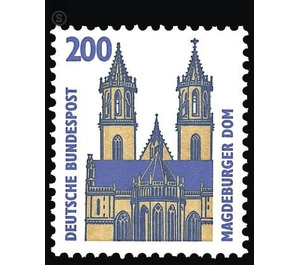Permanent series: sights - Germany / Federal Republic of Germany 1993 - 200 Pfennig
Theme: Architecture
| Country | Germany / Federal Republic of Germany |
| Issue Date | 1993 |
| Face Value | 200.00 |
| Color | white blue |
| Perforation | K 14 |
| Printing Type | indirect 2-color letterpress |
| Stamp Type | Postage stamp |
| Item Type | Stamp |
| Chronological Issue Number | 1538 |
| Chronological Chapter | GER-BRD |
| Michel ID | BRD 1665 |
| SID | 739845 |
| In 55 Wishlists | |
Not far from the Elbe, on the so-called Domfelsen, rises the landmark of the state capital of Saxony-Anhalt, the Magdeburg Cathedral. It is one of the most beautiful and important religious buildings in Germany. Among other things, it gains its special significance from the fact that it is the first Gothic cathedral in Germany. The history of the cathedral dates back to the year 937. This year, the German king and later the first German Emperor Otto I had a Benedictine monastery built on the site of today's cathedral, in which later his deceased wife Editha was buried. In 955, the construction of the first cathedral began above her grave. When a big city fire in Magdeburg raged on Good Friday of the year 1207, this cathedral was almost completely destroyed. In its place 1209 laid the foundation for the high choir of the new Gothic cathedral. However, parts of the old Ottonian cathedral were taken over, for example the twelve ancient columns on which the high choir rests and which were brought under Otto I from Ravenna to Magdeburg. After several interruptions, the cathedral building was not completed until 1520 with the placement of the finial on the north tower. The main portal of the cathedral is located on its imposing western front. It is only open for Easter celebrations and bishoprics. At another portal, the Paradiesportal, which is preceded by the so-called Paradiesvorhalle, is one of the main attractions of the cathedral, the sculptures of the ten wise and foolish virgins, which were created around 1250. They captivate through the masterful and nuanced presentation of emotional impulses, from irrepressible joy to deep despair. If you enter the cathedral through this portal, you will see on the left a memorial of Ernst Barlach for the fallen of the First World War. After its removal by the National Socialists in 1934, it has since 1955 again found its place in the northern transept. In general, the cathedral is rich in outstanding sculptures. These include, for example, the 1240 created figures of St. Catherine and St. Maurice in the high choir. The sculpture of Saint Mauritius is considered in Central Europe as the earliest realistic representation of an African. Also noteworthy are the capitals of the choir, which are considered masterpieces of late Romanesque sculpture. At the same time they document the influence of late Romanesque art on the construction, which was mainly influenced by French Gothic in the elevation and in the ornamentation of buildings. In the high choir there is also the sarcophagus Otto I from the year 973, transferred from the predecessor building and originally preserved. Overall, the history of the cathedral was very varied. When in the Thirty Years' War on 10 May 1631 imperial troops burned Magdeburg, the cathedral remained largely intact. 4,000 citizens of the city had found shelter in the cathedral. In 1810, the Protestant cathedral chapter was dissolved, and the cathedral served at times as a goods magazine and even as a pig and sheep pen. The structure of the cathedral was so bad at the beginning of the 19th century that there were plans to demolish it. After this had been rejected, it came from 1826 to 1834 for the first comprehensive restoration of the cathedral. After the heavy destruction, which had suffered the cathedral in the Second World War, it was usable again only starting from 1955. In the autumn of 1989, the Magdeburg Cathedral was the starting point for the Monday demonstrations that were also held in Magdeburg. At present, a major restoration is underway to repair damage caused mainly by the environment and to preserve the cathedral for the community and more than 100,000 visitors each year. (Text: State Chancellery, Land Sachsen-Anhalt, Magdeburg)
| Condition | Name | In Stock | Price | Price + Shipping | Store | |
|---|---|---|---|---|---|---|
 | Unmounted Mint ** | Permanent series: sights - Germany / Federal Republic of Germany 1993 - 200 Pfennig | 5 | US $1.62 | US $4.83 |  FILATELIELOKET (0) FILATELIELOKET (0)Shipping US $3.22 Minimum Order US $2.69 |


